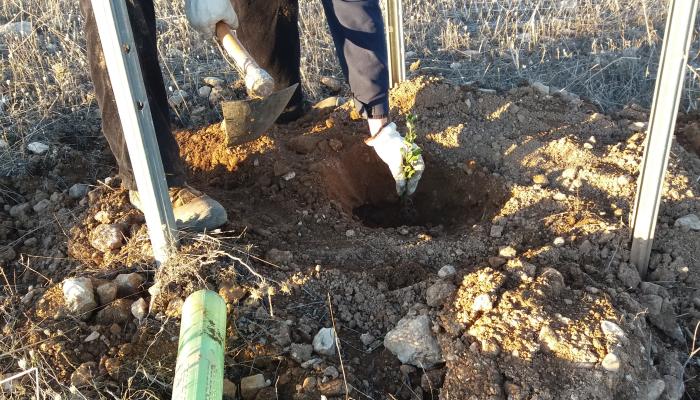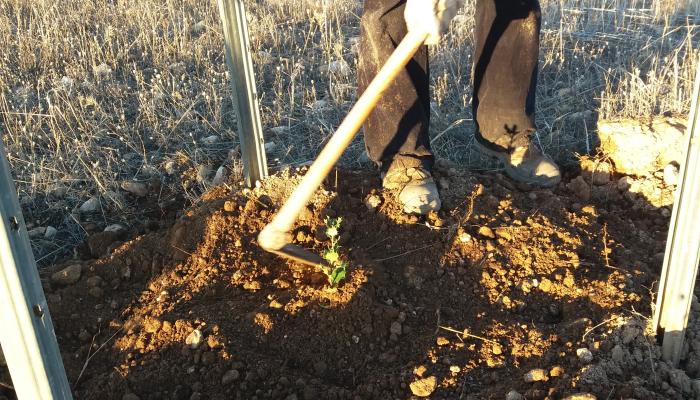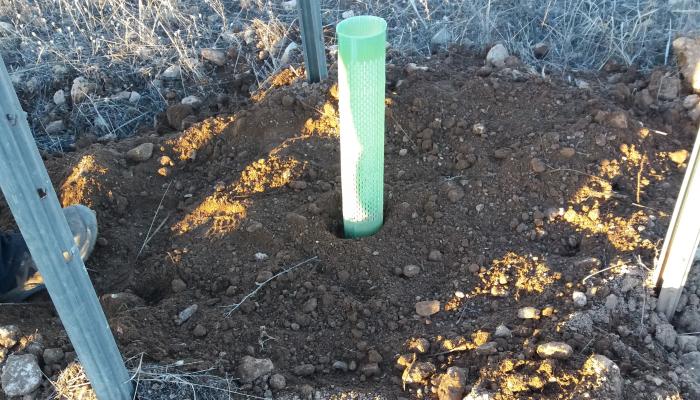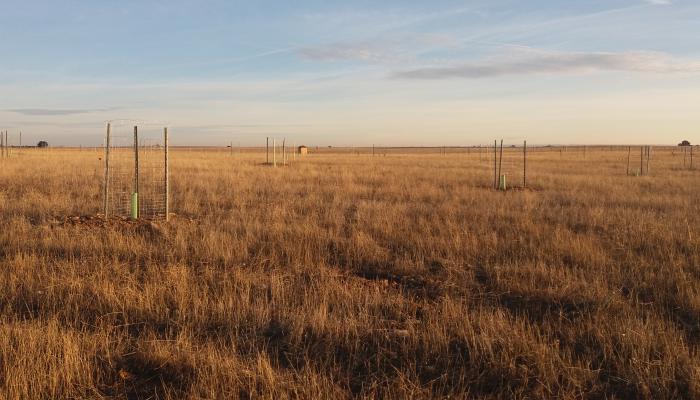










Las Tablas de Daimiel National Park is a protected natural space, a unique Mediterranean wetland of great natural and cultural value due to the hydrographic basin and geology on which it sits. The confluence of two rivers in an area of minimum slope causes their waters to overflow, which together with the underground contribution of a large aquifer leads to the formation of a puddled river zone: the fluvial flats.
The Park holds certain particular protection statuses, including the Special Protection Area for Birds (SPA), Site of Community Importance (SCI), Biosphere Reserve and Ramsar Wetland.
The Park Use and Management Master Plan (PRUG) has corrected some anthropic changes generated in the last decades. A specific corrective measure has been the acquisition and reconversion of old irrigated lands to pastureland (dehesas), characterized by the presence of holm oaks, grasses, wild leguminous plants and annual pastures used for grazing sheep.
At present, ownership of the land in the Las Tablas de Daimiel National Park is almost entirely public, which includes some traditional infrastructures such as fishermen's houses that are considered part of its cultural heritage.
There are no industrial farms in the NP except for some specific traditional reeds or cattail harvesting plots. However, thanks to the high piezometric level of the area, irrigated agriculture has developed in some neighboring areas, in a territory actually characterized by dryland farming. Part of these cultivated lands invade the peripheral protection zone of the Park (5,410 ha), causing damage to the ecosystem and to the local and migrant wildlife in said zone. In addition, the park has a socioeconomic area of influence of 82,174 ha, which includes three municipalities.
Due to the aforementioned problems, the Park has pursued a very active land acquisition policy in recent years, partly motivated by the retrieval of water use rights, as part of the measures aimed at reducing the overexploitation of the hydrogeological unit in the area.
In total, 1,106.50 ha have been acquired and 3,128,871.10 m3 of potential irrigation have been recovered. Different case files have also been processed for dry farming agricultural uses involving traditional livestock use on properties in its Peripheral Protection Zone.
In this sense, the following non-exhaustive list of provisions can be found in article 6.1.3 of the Use and Management Master Plan (PRUG) of the Las Tablas de Daimiel National Park (PN), approved by Decree 87/2017 of December 5 (Official Journal of Castilla La-Mancha of December 18, 2017):
- The acquisition of properties in the peripheral protection zone will be maintained for future expansions of the National Park, prioritizing the purchase of those adjacent to the national park or properties owned by the National Parks Autonomous Body (OAPN), dependent on the Ministry for Ecological Transition, which in turn adjoin the Park.
- The biodiversity of the national park will be increased by developing a program to restore terrestrial habitats. To this end, a mosaic of different plant formations will be recovered, where pastures, patches of Mediterranean forests or natural grasslands are interspersed.
- For the regeneration of treeless areas oriented toward the creation of the pastureland (dehesa), random repopulations will be carried out with native plants of certified origin and always with individual livestock protection measures that guarantee the maintenance of the agroforestry use of the area.
Pursuant to the provisions of the PRUG and concerned about the effects that climate change may have on natural areas such as the one at hand, in 2017 National Park administrators proposed the reforestation of a neighboring property that had been acquired a few years earlier. To this end, it launched the project called “Reconversion of former irrigated farmland to pastureland (dehesa) in the Protection area of Las Tablas de Daimiel National Park” which proceeded forward as part of the Plan to Promote the Environment for Adaptation to Climate Change (PIMA).
Given that PIMA is a set of concrete measures aimed at mitigating the damages that this climate change phenomenon may cause in our country and preparing for those that may foreseeably occur, it was considered that the project fitted perfectly into the philosophy of this Plan, as these measures include the launching of initiatives geared at adaptation management of forest stands and reforestation aimed at reducing and/or offsetting carbon dioxide (CO2) emissions.
The project basically consisted in the reforestation of an area of 104 ha with oaks in the area known as La Duquesa, belonging to an old farm bordering the National Park and dedicated to large-scale or intensive irrigation.
The main objective of this undertaking was to restore the original pastureland (dehesa) typical of the area, characterized by the presence of holm oaks, grass pastures, wild leguminous plants and annual pastures, usable for ovine cattle grazing by La Mancha sheep. In addition, the subsequent development of the restored pasture also serves mitigation-wise as a CO2 sink.
The area chosen for reforestation was located in the Protection Area of the National Park, identified as polygon 2, plot 6 of the municipality of Daimiel, occupying an area of 202.72 ha, of which 104 ha were reforested, that is, slightly more than half.
The lands were acquired by OAPN in December 2007 and overall were a hard, carbonated calcisol (CLp) soil type, with carbonates being the most representative and characteristic lithology of the area.
The OAPN has been acquiring properties in the protection zone of the National Park since 1999 (LIFE project), in order to create a perimeter that is capable of buffering the effects of human activities in the surroundings of the protected area, mainly those produced by intensive or large-scale agriculture (water withdrawal from the aquifer, pollution generated by the use of inorganic fertilizers or phytosanitary products, ...), as well as to seek environmental improvements that include the recovery of the different terrestial habitats that were naturally present in the surroundings of the National Park, while achieving at the same time an increase in its biodiversity.
In this sense, since 2001 various works have been taking place, including afforestation in agricultural land, transformation of olive groves in the mountains, promotion of natural pastures and restoration of the original singular pastureland (dehesa) overlying the limestone substrate that existed in many places, which is the objective of the afforestation work planned.
In addition to the main objectives indicated, the development of the project with the creation of the new forest mass, seeks the following medium and long-term goals:
- increasing the biological diversity of the habitat
- serving as a corridor for the safe movement of plant and wildlife, the connection generated between this habitat and other habitats in the protected area being of high importace
- increasing the chances of survival of various animal species by serving as a refuge, food and nesting area
- contributing to the maintenance and security of the aquifers from a hydraulic perspective, with the reduction of the area devoted to irrigation
Given the thermopluviometric and soil characteristics as well as its altitude and latitude, the study area was was included in the mesomediterranean bioclimatic level, represented by the series of alkaline Castilian-Aragonese mesomediterranean vegetation consisting of oak forests, with Quercus ilex, ballota subspecies being the maximum representative of the climatic community. As a result, Quercus was selected for afforestation.
This series occupies the largest area and its mature stage consists of an oak grove overlying alkaline-rich soils, with rainfall ranging between 350 and 550 mm per year. However, the agricultural transformations that have occurred in the area have been progressively reducing this type of plant formations, with only a few very degraded stands and very open pastureland patches remaining today that prove the existence of the dominance of this series throughout the territory in times past.
For the reforestation tasks in this case, the seedlings came from the cultivation of seeds collected in the National Park itself, in the area known as Quinto de la Torre.
Said seeds were collected in the fall of 2016, over an area of 125 ha in the National Park itself with a large number of parent trees, in an attempt to achieve the greatest possible genetic diversity and the future adaptability of the seedlings to the terrain.
The seeds were subsequently grown at TRAGSA’s greenhouse. Plants had the MANCHA certificate of origin.
Since the objective of afforestation was to achieve the restoration of the original pastureland (dehesa) overlying the limestone substrate that existed in many of the places in the surroundings of the Park, including the area selected before its transformation into irrigation land, an attempt was made to reproduce the arrangement of the trees in the pastures currently existing in the area (Zacatena and Casablanca). Finally, a random distribution of the plants was chosen, with a plantation density of about 50 ft/ha and with distances between plants of at least 15 m. Since 104 ha were replanted, the total number of plants used in the project amounted to 5,200.
The lands were cultivated until the moment of their acquisition after 11 years of inactivity. This was of utmost important for the new seedlings, which, as a result, would gain access to a soil with substantial improvements in terms of nutrients and the ability to provide them with greater vitality and quality.
Planting was done by hand by a team of professionals specialized in this type of work. The seedlings were supplied in rigid black trays (50 units), with 250 cm3 cells filled with organic substrate, mainly peat-based.
The appearance of the seedlings was consistently good, with no lesions, malformations, puncturing of the leaves or other apparent damage. All had a good consistency, turgidity, liveliness and leaf size.
Ground preparation was limited to 90x90x90-cm holes dug mechanically with a backhoe, with no other areas of the plot being cleared. Next, the removed ground had to be leveled, avoiding leaving heaps that could prevent the correct planting and installation of the subsequent protective fencing.
Next, a sufficient amount of soil was opened and removed to accommodate the plant comfortably so that the root ball could be properly buried. This job included the installation of a 60 cm high biodegradable protective tube.
The size of the hole (somewhat larger than normal) facilitated the nailing of three posts driven into the ground to anchor the individual protective mesh placed around each plant, in order to avoid damage by wildlife or livestock.
In addition, the increase in the depth also increased the water availability of the plant, much needed in climates as scarce in rainfall as the one existing in this location.
Subsequently, the surrounding land was trodden so that the removed soil came into contact with the root ball of the seedlings, avoiding any possible air pockets that could generate rooting problems.
Lastly, a pit was dug out and built around the tree to increase the rainwater collection and conservation capacity, which is of utmost importance, especially in areas where it is usually very scarce, as in the case of La Mancha.
The most relevant aspect of this project is the replacement, on a 104 ha plot bordering the National Park, of an intensive irrigated crop as a result of the establishment of an oak meadow.
Removal of some of these irrigated crops implies an improvement in the water table of the area, which, in turn constitute one of the most important water contributions of the wetland.
The project was carried out in accordance with the provisions made reference to article 6.1.3 above of the Master Plan for the Use and Management of the Park (PRUG). The project was developed under the oversight of the National Park’s Technical Services, through secondment to the Public company TRAGSA, which in turn subcontracted to two companies in the area a couple of project line items involving the mechanized boring and driving of posts for the installation of protective mesh.
However, in a previous preliminary phase, some of the Park's own personel participated and were in charge of the collection and selection of seeds in the area known as Quinto de la Torre inside the same National Park, on an extension of 125.63 ha and from a large number of parent trees, in order to seek their greater genetic diversity and future adaptability to the terrain.
The selected seeds were transferred to a TRAGSA greenhouse for germination and care and obtained the MANCHA certificate of origin. They remained there until November 2017, when they were taken to the Park for planting.
These preliminary activities resulted in no added costs to the project. All actions were carried out in coordination and under the supervision of the Park's Technical staff.
The state of conservation of the Park and the problems that have arisen to date are the result of the interaction of a series of factors, both natural and of anthropic origin, and the complex relationships and synergies generated in this regard in a particularly fragile enclave, given it is a wetland immersed in a dry land environment.
The effect of some processes such as droughts, which are increasingly frequent and intense as a consequence of climate change, have a great influence on the Park, whose main problems are the consequence of the deficient management and organization carried out until recently with respect to the water resources of the area, hindering the conservation and recovery of habitats and ecosystems as well as the possibility to manage its resources sustainably.
Excessive water withdrawal in the area, both via direct extraction of surface water and overexploitation of groundwater, carried out intensively for years, has caused significant damage to the ecosystem, which has transitioned from a traditional agricultural rainfed farming proper to the region, to a predominant irrigated crops system with a high demand for water, which has led to the overexploitation of water resources.
All this has caused a decrease in the water table and a reduction in the size of the flooded area, in addition to contamination problems and eutrophication processes in the lagoons due to the concentration of nutrients from the lands surrounding the channels, which has contributed to the degradation process and a decrease in the quality of the fluvial flats.
In recent years, the water table in the area has recovered due to the increase in rainfall and improvements in the management system of the Park and its area of influence, but not to a potential decrease in consumption; as a result, water availability in new periods of drought will return to levels that are below the minimum necessary to allow its proper functioning.
This means that, in order to bring back the water levels to their optimum level, irrigated land should be eliminated to the point that sustainable management of this resource can be effectively carried out.
For all the above reasons, this project for the reconversion of irrigated cultivation lands to La Mancha Mediterranean dry land pastures, along with the restoration of surfaces through the use of holm oaks, grasses (Poaceae family), wild leguminous plants (Fabaceae family) and annual pastures, is particularly interesting, and also allows for the conservation and recovery of the ecosystem, the restoration of the water balance in the affected area, and the optimal use of its ecosystem resources, thus improving the socioeconomic conditions of the environment with the recovery of rural tourism and grazing of Manchego sheep.
In this sense, similar actions must continue, eliminating irrigated land to achieve a reduction in water consumption and an adequate reconversion of the land, shifting the structure of the agricultural sector toward a more sustainable management of the system in order to recover the hydrological dynamics of the Park.
Introducing technical improvements and promoting a socio-economic change in the crop structure toward a sustainable agriculture system that is compatible with the balance of the ecosystem will allow improving the quality of the Park and restoring its natural operating conditions, along with an optimization of its ecosystem services that will undoubtedly have a positive, long-term impact on the socioeconomic development in the area.
Making it through the first summer is the foundation for the success of the afforestation or restoration of native vegetation in the Mediterranean climate, and, therefore, the date of planting is key for the plants in order to be able to develop a root system that provides them with sufficient water availability and the strength to face the high summer evapotranspiration.
The latter is seldom possible due to the execution times of the various tasks, climate or the characteristics of the plants; therefore, external contributions must be made to improve the water balance of the plants during this period.
There are two approaches to this problem in this regard:
- improve or control the supply of water (irrigation)
- reduce the degree of insolation suffered by plants
The implementation of an irrigation system considerably increases running costs or is impossible to implement altogether due to the inaccessibility of the land or the lack of a source of constant water supply. Therefore, it is customary to act on the second option, placing individual protections that provide shade and improve water conditions, in addition to serving as protection against predators.
As a limiting factor, one of the problems afforestation faces is the damage caused by wildlife (wild boars) or domestic livestock (sheep, goat), which usually browse, trample, scratch or fracture seedlings. To avoid these damages as much as possible, a 1.5 m high galvanized knotted 148/18/15 protective mesh girded around three metal posts was installed on each level.
The budget for this reconversion project of irrigated cultivation land to pastureland (dehesa) in La Mancha amounted to € 83,580.17, and was financed in full by the Spanish Office for Climate Change.
The project is subject to the different laws and decrees that affect the structure and entity of the Park itself.
The Las Tablas de Daimiel wetland was declared a National Park in 1973 by Decree 1874/1973 of June 28, which declared the Tablas de Daimiel National Park as such and created an Integral Reserve Area for aquatic birds within it (BOE 181, June 30, 1973).
Likewise, the park was reclassified in 1980 by Law 25/1980 of May 3, on the Reclassification of Las Tablas de Daimiel National Park.
The establishment in 2007 of the competencies over its management, through the enactment of Law 5/2007 of April 3 that references the National Park Network.
Later, on January 27, 2014, the limits of the Park were expanded through the incorporation of adjacent land, according to a resolution dicated by the Council of Ministers of January 10, 2014.
On December 4 of the same year, Las Tablas de Daimiel National Park was affected by the new Law 30/2014 on National Parks.
The project underwent a previous seed collection and selection phase that was carried out in advance during the month of October 2016, as well as a subsequent germination, development and care of the seedlings phase carried out in a TRAGSA greenhouse, where the seedlings remained until November 2017.
However, the actual afforestation-reforestation project was also carried out by Tragsa personnel, with the assistance from Park Technical Staff during the months of November and December 2017, with a total duration of two months.
In short, this means that, overall, the preparation and execution of the project would have an actual duration of 14 months, although its final results will be seen in the coming years.
During December 2018, and in collaboration with WWF-Spain, work was also carried out on the restoration of a new pastureland area on the same affected limestone plot, with the planting of about 50 feet/ha. However, it is a complementary action not included in this project. The works were also carried out by an external contractor (Retamar - Obras y Servicios y Medio Ambiente SL.).
- Alloza J.A.; Vallejo R. 1999. Relación entre las características meteorológicas del año de plantación y los resultados de las repoblaciones. Ecología, 13: 173-187.
- Birchler T. et al. 1998. La planta ideal: revisión del concepto, parámetros definitorios e implementación práctica. Invest. Agr.: Sist. Recur. For., 7(1- 2).
- Brais Hermosilla L. 2016. Elaboración de un protocolo para el muestreo en el seguimiento de repoblaciones forestales. Máster Universitario en restauración de ecosistemas. Universidad de Alcalá de Henares.
- De María A.; Touriño l.; Manzano I.; Domínguez M. 2003. Técnicas de gestión forestal sostenible en la repoblación forestal. SILVANUS ESPAÑA Y SILVANUS GALICIA.
- Díaz-Cambronero A. 2017. Protocolo para el monitoreo de la forestación realizada en el Parque Nacional de Las Tablas de Daimiel. PIMA. TRAGSA. 41 pp.
- Domínguez S.; Villar P.; Peñuelas J.L.; Herrero N. 1999. Técnicas de implantación de encinas en terrenos agrícolas. Quercus, 166: 22-25.
- Gómez V.; Elena R. 1997. Investigación de las marras causadas por factores ecológicos de naturaleza meteorológica. Cuadernos de la S.E.C.F., 4: 13-25.
- Iglesias A. 2004. Repoblaciones con Quercus ilex L. en zonas degradadas de la provincia de Ávila. Técnicas para mejorar su supervivencia. Tesis doctoral. Universidad Politécnica de Madrid. Escuela Técnica Superior de Ingenieros de Montes.
- Jódar A.; Albaladejo J.A.; Fernández H. 2016. Análisis de la Evolución y Estado Actual del Parque Nacional Las Tablas de Daimiel (Cuenca Alta del Guadiana, España). CONAMA 2016. 28 Noviembre - 1 Diciembre. Madrid. 81 pp.
- Morote A.; Orozco E.; Jordán E.; López F.; Herranz J.M.; Martínez J.J.(2001. Evaluación mediante parámetros morfobiométricos de ocho especies autóctonas de matorral empleadas en la forestación de terrenos agrícolas de La Mancha. Escuela Técnica Superior de Ingenieros Agrónomos. Campus universitario. Albacete.
- Pemán García J. 1997. El control de calidad de las repoblaciones forestales. Rev. Montes, 45: 23-30.
- Peñuelas J.L.; Ocaña l.; Domínguez S.; Renilla I. 1996. Experiencias sobre control de la competencia herbácea en repoblaciones de terrenos agrícolas abandonados. Resultados de tres años en campo. Rev. Montes, 45: 30-36.
- Serrada R.; San Miguel A. Selvicultura en dehesas. Departamento de silvopascicultura. Universidad Politécnica de Madrid.
- Serrada R.; Navarro R.M.; Pemán J. 2005. La calidad de las repoblaciones forestales: una aproximación desde la selvicultura y la ecofisiología. Invest Agrar: Sist Recur For, 14(3): 462-481.
- Serrada R. 2000. Apuntes de Repoblaciones Forestales. FUCOVASA. Madrid.
- Carlos Ruiz de la Hermosa
Parque Nacional de Las Tablas de Daimiel
Organismo Autónomo Parques Nacionales (OAPN)
Correo electrónico: caruiz@oapn.es
Teléfono: 926851097
- Manuel Carrasco Redondo
Parque Nacional de Las Tablas de Daimiel
Organismo Autónomo Parques Nacionales (OAPN)
Correo electrónico: MCarrasco@oapn.es
Teléfono: 926851097





